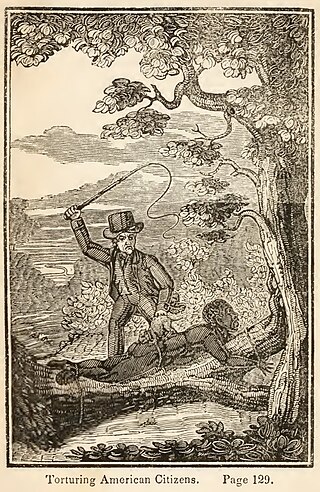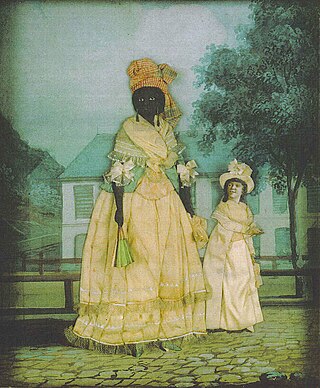Related Research Articles

Slavery in the colonial history of the United States refers to the institution of slavery as it existed in the European colonies which eventually became part of the United States. In these colonies, slavery developed due to a combination of factors, primarily the labour demands for establishing and maintaining European colonies, which had resulted in the Atlantic slave trade. Slavery existed in every European colony in the Americas during the early modern period, and both Africans and indigenous peoples were victims of enslavement by European colonizers during the era.

The legal institution of human chattel slavery, comprising the enslavement primarily of Africans and African Americans, was prevalent in the United States of America from its founding in 1776 until 1865, predominantly in the South. Slavery was established throughout European colonization in the Americas. From 1526, during the early colonial period, it was practiced in what became Britain's colonies, including the Thirteen Colonies that formed the United States. Under the law, an enslaved person was treated as property that could be bought, sold, or given away. Slavery lasted in about half of U.S. states until abolition in 1865, and issues concerning slavery seeped into every aspect of national politics, economics, and social custom. In the decades after the end of Reconstruction in 1877, many of slavery's economic and social functions were continued through segregation, sharecropping, and convict leasing.

The Fugitive Slave Act or Fugitive Slave Law was a law passed by the 31st United States Congress on September 18, 1850, as part of the Compromise of 1850 between Southern interests in slavery and Northern Free-Soilers.
The StonoRebellion was a slave revolt that began on 9 September 1739, in the colony of South Carolina. It was the largest enslaved rebellion in the Southern Colonies, with 25 colonists and 35 to 50 Africans killed. The uprising was led by native Africans who were likely from the Central African Kingdom of Kongo, as the rebels were Catholic and some spoke Portuguese.

The slave codes were laws relating to slavery and enslaved people, specifically regarding the Atlantic slave trade and chattel slavery in the Americas.

The Barbados Slave Code of 1661, officially titled as An Act for the better ordering and governing of Negroes, was a law passed by the Parliament of Barbados to provide a legal basis for slavery in the English colony of Barbados. It is the first comprehensive Slave Act, and the code's preamble, which stated that the law's purpose was to "protect them [slaves] as we do men's other goods and Chattels", established that black slaves would be treated as chattel property in the island's court.
The Black Codes, sometimes called the Black Laws, were laws which governed the conduct of African Americans. In 1832, James Kent wrote that "in most of the United States, there is a distinction in respect to political privileges, between free white persons and free colored persons of African blood; and in no part of the country do the latter, in point of fact, participate equally with the whites, in the exercise of civil and political rights." Although Black Codes existed before the Civil War and although many Northern states had them, the Southern U.S. states codified such laws in everyday practice. The best known of these laws were passed by Southern states in 1865 and 1866, after the Civil War, in order to restrict African Americans' freedom, and in order to compel them to work for either low or no wages.

In the British colonies in North America and in the United States before the abolition of slavery in 1865, free Negro or free Black described the legal status of African Americans who were not enslaved. The term was applied both to formerly enslaved people (freedmen) and to those who had been born free, whether of African or mixed descent.

Slavery in the Spanish American colonies was an economic and social institution which existed throughout the Spanish Empire including Spain itself. In its American territories, early Spanish monarchs put forth laws against enslaving Indigenous peoples of the Americas. Queen Isabella outlawed the enslavement of Native Americans in the Spanish colonies of the New World because she viewed the natives as subjects of the Spanish monarchy. While Spain displayed an early abolitionist stance towards the Indigenous, some instances of illegal Native American slavery continued to be practiced by rogue individuals, particularly until the New Laws of 1543 which expressly prohibited it.
South Carolina was one of the Thirteen Colonies that first formed the United States. European exploration of the area began in April 1540 with the Hernando de Soto expedition, which unwittingly introduced diseases that decimated the local Native American population. In 1663, the English Crown granted land to eight proprietors of what became the colony. The first settlers came to the Province of Carolina at the port of Charleston in 1670. They were mostly wealthy planters and their slaves coming from the English Caribbean colony of Barbados. They started to develop their commodity crops of sugar and cotton. The Province of Carolina was split into North and South Carolina in 1712. Pushing back the Native Americans in the Yamasee War (1715–1717), colonists next overthrew the proprietors' rule in the Revolution of 1719, seeking more direct representation. In 1719, South Carolina became a crown colony.
Antebellum South Carolina is typically defined by historians as South Carolina during the period between the War of 1812, which ended in 1815, and the American Civil War, which began in 1861.

Partus sequitur ventrem was a legal doctrine passed in colonial Virginia in 1662 and other English crown colonies in the Americas which defined the legal status of children born there; the doctrine mandated that children of slave mothers would inherit the legal status of their mothers. As such, children of enslaved women would be born into slavery. The legal doctrine of partus sequitur ventrem was derived from Roman civil law, specifically the portions concerning slavery and personal property (chattels), as well as the common law of personal property.

Slavery in New Jersey began in the early 17th century, when Dutch colonists trafficked African slaves for labor to develop the colony of New Netherland. After England took control of the colony in 1664, its colonists continued the importation of slaves from Africa. They also imported "seasoned" slaves from their colonies in the West Indies and enslaved Native Americans from the Carolinas.
The Virginia Slave Codes of 1705, were a series of laws enacted by the Colony of Virginia's House of Burgesses in 1705 regulating the interactions between slaves and citizens of the crown colony of Virginia. The enactment of the Slave Codes is considered to be the consolidation of slavery in Virginia, and served as the foundation of Virginia's slave legislation. All servants from non-Christian lands became slaves. There were forty one parts of this code each defining a different part and law surrounding the slavery in Virginia. These codes overruled the other codes in the past and any other subject covered by this act are canceled.

Slavery among Native Americans in the United States includes slavery by and slavery of Native Americans roughly within what is currently the United States of America.

Invisible churches among enslaved African Americans in the United States were informal Christian groups where enslaved people listened to preachers that they chose without their slaveholder's knowledge. The Invisible churches taught a different message from white-controlled churches and did not emphasize obedience to slave masters. Some slaves could not contact invisible churches and others did not agree with an invisible church's message but many slaves were comforted by the invisible churches.

Anti-literacy laws in many slave states before and during the American Civil War affected slaves, freedmen, and in some cases all people of color. Some laws arose from concerns that literate slaves could forge the documents required to escape to a free state. According to William M. Banks, "Many slaves who learned to write did indeed achieve freedom by this method. The wanted posters for runaways often mentioned whether the escapee could write." Anti-literacy laws also arose from fears of slave insurrection, particularly around the time of abolitionist David Walker's 1829 publication of Appeal to the Colored Citizens of the World, which openly advocated rebellion, and Nat Turner's slave rebellion of 1831.
John Belton O'Neall (1793–1863) was an American judge who served on the precursor to the South Carolina Supreme Court. He is remembered for writing the digest The Negro Law of South Carolina.

Slavery in Florida is more central to Florida's history than it is to almost any other state. Florida's purchase by the United States from Spain in 1819 was primarily a measure to strengthen the system of slavery on Southern plantations, by denying potential runaways the formerly safe haven of Florida.
The Negro Law of South Carolina (1848) was one of John Belton O'Neall's longer works.
References
- ↑ Konadu, Kwasi (2010-05-12). The Akan Diaspora in the Americas. Oxford University Press. ISBN 978-0-19974538-8.
- ↑ "Slavery and the Making of America. Timeline | PBS". www.pbs.org. Retrieved 2017-10-09.
- ↑ Gabbatt, Adam (24 October 2017). "A sign on scrubland marks one of America's largest slave uprisings. Is this how to remember black heroes?". Guardian US. Retrieved 24 October 2017.
- ↑ Morris, Thomas (21 Jan 2004). Southern Slavery and the Law, 1619-1860. Univ of North Carolina Press. p. 350. ISBN 9780807864302 . Retrieved 4 June 2018.
- 1 2 O'Neall, John Belton. "The Negro Law of South Carolina". Internet Archive. J.G. Bowman. Retrieved 29 May 2018.
 This article incorporates text from this source, which is in the public domain .
This article incorporates text from this source, which is in the public domain . - ↑ Penningroth, Dylan (21 July 2004). The Claims of Kinfolk: African American Property and Community in the Nineteenth-Century South. UNC Press Books. p. 208. ISBN 9780807862131 . Retrieved 4 June 2018.
- ↑ Finkelman, Paul (17 December 2001). Slavery & the Law. Rowman & Littlefield. p. 216. ISBN 9780742521193 . Retrieved 3 June 2018.